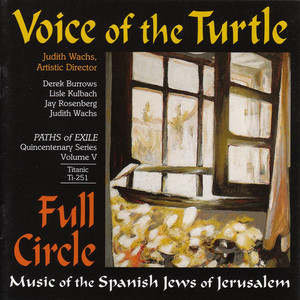
Full Circle: Music of the Spanish Jews of Jerusalem
- 流派:World Music 世界音乐
- 语种:英语
- 发行时间:1997-12-01
- 类型:录音室专辑
- 歌曲
- 时长
简介
Full Circle Music of the Spanish Jews of Jerusalem Paths of Exile Quincentenary Series, Volume V Voice of the Turtle Judith Wachs, Artistic Director Derek Burrows: mandolin, guitar, bagpipe, saz, harp, psaltery, dumbeks, finger cymbals and voice Lisle Kulbach: kamanja, viola da gamba, violin, harp, flute and voice Jay Rosenberg: cornetto, tenor chalumeau, ‘ud, guitar, clarinet, derbouka, dumbek, riqq, tambourine and voice Judith Wachs: nay, soprano chalumeau, flute, baglama, tambourine and voice THE SEPHARDIM In 1492, all the Jews of Spain (Sephardim, from the Hebrew word for Spain, Sefarad, found in Obadiah 1:20]) who refused to renounce their faith, as required by the Inquisition, were expelled from their homeland of 1500 years. The Ottoman Empire welcomed this educated population, who brought with them technological skills so valuable to the aspirations of the Empire. But despite this hospitality, and because of the Ottoman policy of allowing their minorities almost total autonomy, these exiles continued to identify themselves as Spanish Jews, preserving the old Castilian language, and much of the culture of their Iberian experience. Because music was so central to their daily lives, particularly in the domain of women, they were able to preserve this astonishing musical heritage for five hundred years by oral tradition. THE QUINCENTENNIAL In 1992, the western world marked the Quincentenary – the 500th year since the momentous voyage of Christopher Columbus. Voice of the Turtle hopes to expand the modern perception of that history through its series of CDs called the “Paths of Exile.” This special recording project will enhance the significance of the Quincentenary from the little known perspective of the Jews of Spain. This third volume follows the “path” of Bulgaria and Yugoslavia. JUDEO-SPANISH The medieval Castilian Spanish spoken by the Jews of Spain at the time of the expulsion is called Judeo-Spanish, Judeo-español, Djudezmo, ‘Spanyolit, ‘Spaniol de mosotros, and Sephardi. The language was spoken and written, first in Hebrew characters and recently, in the Latin alphabet. It was preserved in exile largely by the women, whose insulated life protected the language and maintained its vitality. It is often called “Ladino,” which historically was the language emerging from Latin into which liturgical Hebrew texts were translated. The word comes from the old Spanish “ladinar,” which means “to translate from Arabic or Hebrew into Latin or a latinate language.” ABOUT THIS COLLECTION – Judith Wachs , Artistic Director Full Circle presents secular musical traditions preserved by the community of Spanish Jews in Jerusalem. The collection was chosen from the repertoire belonging to people who identify themselves as “Yerushalmi” – i.e., of Jerusalem – a community of people whose families have lived in the city for many generations. The selections represent a variety of musical and poetic expressions preserved and inspired by ordinary experiences such as oppression, poverty, war and expulsion. Off to war, a young man consoles his mother (“A la gerra me vo ir”); a man regrets the errors of his youth (“Yo era un leoniko”). A mother suffers (tongue-in-cheek) the public shame of her disheveled child (“Moshon”). A young wife vilifies her mother-in-law in good humor (“Mi suegra”), bearing in mind that often the young couple lived with the mother of the groom. A community of listeners to the ‘Ladino’ radio program on Kol Yisrael are moved to compose a Ladino text to a popular song from the War of Independence (“Madres amargadas”). Ladino words are composed to an Arabic folk song, popular in Jerusalem (“Intri las huertas”). A mother counsels a son on choosing a wife (“Bastuniko”), and the community wishes the poor bride mazal bueno, good luck, even if she has no dinero (“Skalerika de oro”). These ordinary experiences are reflective of the community’s determination to maintain a normalcy woven out of passion, humor, wayward youth, parental concern and love – at the same time as it struggled for survival amid volatile realities. FULL NOTES, TEXT AND TRANSLATIONS AVAILABLE ON THE CD BOOKLET

